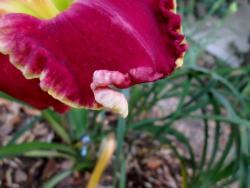chalyse said:If I understand correctly, both double daylilies and sports are considered to be mutations, but that they are separate genetic effects
Whether a double flower is a mutation or is not a mutation depends on something that we cannot know simply by looking at the plant or its flowers. A mutation requires a change in the DNA sequence of a gene.
If we have a daylily cultivar that produces only single flowers and we knew that it was 'normal' or 'wild-type' in all the genes that could affect doubling of flowers then if that cultivar produced a fan that had double flowers and if that fan had one of those genes changed from the normal then it would be a new mutation that caused the doubling. Presumably if we bred from that fan the seedlings would inherit the mutation and be genetically different from seedlings bred from the other fans that produced only single flowers. The double flowers were produced by a genetic effect and therefore were sports.
On the other hand if we had a daylily cultivar that produces only single flowers and one day it produced a double flower and we knew that none of the genes were different in sequence between the single flowers and the double flowers then the double flower was not produced by a new mutation. If we bred from the double flower the seedlings would not be genetically different from those that we produced from the single flowers. The double flower was not produced by a genetic effect but it was produced by a developmental effect. The double flower was not a sport.
chalyse said:In the case of doubles it has resulted in a gene that hybridizers worked to increase in frequency, so that with environmental assistance there would be more frequent cultivars with that naturally-found doubling trait.
Genes and their mutations never work entirely in isolation. Their effects depend on many other genes. What we could have in double daylilies is that there might be one gene that had an allele that produced double flowers. It might be dominant or it might be recessive but by itself it produced double flowers only rarely. By selecting for consistency and higher frequencies of doubling hybridizers will have changed the frequencies of alleles at other genes.
In a typical sexually reproducing non-clonal species every individual is genetically different. When geneticists want to study the effects of a new mutation they put the new mutation into an inbred line. They do this by back-crossing the mutation into the inbred line for many generations until the result is that they have individuals that are genetically identical without the new mutation or with the new mutation. They can then see what effects the new mutation has in that inbred line. That is described as seeing what effects the mutation has on that specific genetic background. They can repeat the back-crossing with a different inbred line and the same mutation and see what effects are different because of the different genetic background. When one does this for a number of different genetic backgrounds one finds that the effects of a mutation are different depending on the genetic background (the environment is kept the same). A new mutation that causes flower doubling 99% of the time in one genetic background might have no effect in some genetic backgrounds while in others doubling might occur only 50% of the time and so on (the environment kept the same). This is the case for most mutations but is especially so for the type of mutations that cause flower doubling. Daylily hybridizers will have selected for genetic backgrounds in which double flowers appear frequently. Some of them would also have selected for genetic backgrounds in which hose-in-hose type doubling occurs more frequently and others selected for other genetic backgrounds in which peony doubling occurs more frequently and so on.
chalyse said:It's cool to know that doubles do not always perform the same depending upon temperature conditions, and I'd never heard that warm growing zones like I am used to are more likely to get and see such doubling. It also sounds like you may be saying that sport, in that aspect, are the same - the environment will possibly influence and shape the nature of its appearance.
A basic foundation of genetics is that Phenotype = Genotype + Environment + Genotype X Environment Interaction.
Each specific phenotype or characteristic of a plant may depend more or less on each of these factors. Mutations (or alleles) with very large visible effects on characteristics may depend predominantly on genotype with minor influences from the environment, etc. Others may depend more on the environment and so on.
chalyse said:I wonder if it is possible that a sport might show two aspects of genetic difference, like doubles that also have fringing (not genetic?), or to lose some characteristics (no complexity found in the eye) when others get expressed?
Yes, that is called pleiotropy. A mutation can affect two or more different characteristics. Often the effects are obviously related. An example might be a mutation that changed the colour of flowers might also change the colour of roots or possibly of leaves, etc. Sometimes they are less obvious - a mutation that changed the colour of flowers might also change the plant's susceptibility to some disease. Typically with visibly obvious mutations there is one predominant effect (qualitative) with perhaps other minor effects that require measuring to identify (quantitative).

